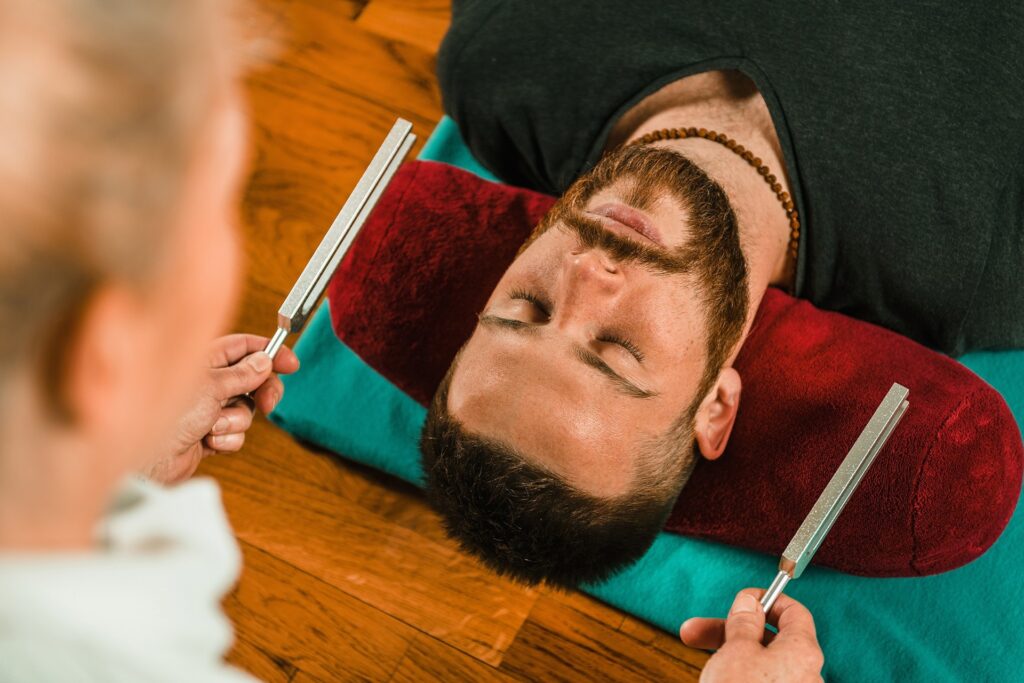What is Sound Healing? Can sound healing help with depression?

Facebook
Twitter
LinkedIn
WhatsApp
What is sound healing and its origins?
A therapeutic technique known as sound healing uses the healing potential of good vibrations to advance mental, emotional and spiritual health. Its roots can be found in ancient civilizations like the Egyptians, Greeks and Indigenous tribes, who understood the significant effects of sound on people’s physical and psychological well-being. These societies thought certain tones and frequencies may help a person heal by restoring balance and harmony. Singing bowls, gongs, drums and the human voice are just a few of the instruments used in sound healing to produce resonant tones that help entrain brainwaves, lower stress levels, lessen pain and restore energetic flow. Good rehab is still developing as a holistic modality, fusing conventional wisdom with cutting-edge research.
Fundamental ideas that direct sound healing’s use and effectiveness are found at its heart. The idea of resonance, which asserts that everything in the cosmos vibrates at a particular frequency, is one such principle. Harmony and balance are said to be reestablished by exposing the body to particular frequencies via sound. Entrainment, which is the process through which the body’s vibrations align with outside sound frequencies, is another principle. This synchronisation is supposed to encourage relaxation, lower stress levels, and improve general wellbeing. Additionally, sound healing recognises the mind-body link and how sound vibrations can affect a person’s emotional and spiritual well-being in addition to their physical health.
The belief in the power of sound vibrations for healing has been deeply rooted in cultures throughout history. Across various civilizations, there has been a shared understanding that sound possesses a transformative quality capable of positively affecting the human body, mind and spirit. This belief stems from recognizing that sound is energy, and different frequencies can induce profound shifts in our being. Advocates of sound healing assert that specific vibrations can restore balance, clear energetic blockages and stimulate the body’s innate healing abilities. While modern science is still uncovering the mechanisms behind sound healing, the belief in its potential for holistic well-being continues to be embraced and explored by individuals seeking alternative approaches to health and wellness.
The Science behind Sound Healing:

The impact of sound vibrations on our bodies and brainwaves is a fascinating area of study. When we are exposed to specific frequencies and tones, our bodies respond on a cellular level. Sound vibrations can penetrate deep into our tissues, promoting relaxation, reducing muscle tension and even assisting with pain management. Furthermore, these vibrations can influence our brainwaves and the electrical patterns our brains produce. Different sound frequencies can entrain our brainwaves, guiding them into calmness, focus or meditative states. This modulation of brainwaves can profoundly affect our mental states, promoting clarity, creativity and emotional balance. The intricate interplay between sound vibrations, our bodies and brainwaves opens up possibilities for healing and well-being.
The connection between sound frequencies and cellular resonance lies in the principle that cells have their own inherent vibrational frequencies. Each cell in our body has its own unique resonant frequency and when exposed to external sound vibrations, they can entrain and synchronize with those frequencies. This process of cellular resonance is believed to enhance cellular communication, promote healthy cellular functioning and restore balance within the body. Research has demonstrated that specific sound frequencies can impact cellular activities, such as promoting the release of neurotransmitters, stimulating mitochondrial function and optimizing cellular metabolism. The concept of cellular resonance underscores the potential of sound healing to positively influence the fundamental building blocks of our bodies, supporting overall well-being.
Scientific research and studies have been conducted to explore and support the effectiveness of sound healing as a therapeutic modality. One area of investigation focuses on the impact of good vibrations on the autonomic nervous system, revealing that specific frequencies can induce a relaxation response, reduce heart rate and lower blood pressure. Neuroimaging studies have demonstrated changes in brainwave patterns, suggesting that sound healing can influence neural activity associated with stress reduction and heightened states of consciousness. Moreover, research has shown the positive effects of good recovery on various health conditions, including pain management, anxiety and sleep disorders. These studies provide empirical evidence supporting the potential of sound healing as a complementary approach to holistic well-being.
Different Modalities of Sound Healing:

Exploring various sound healing techniques unveils a rich tapestry of modalities that harness the power of sound for healing and transformation. Singing bowls, often made of metal, produce resonant tones when struck or rubbed, creating a soothing and immersive auditory experience. Tuning forks, on the other hand, emit precise frequencies that can be applied directly to specific points on the body, facilitating energetic alignment. “Chanting”, an ancient practice in many spiritual traditions, utilizes repetitive vocalizations to induce a meditative state and stimulate vibrational healing. Other techniques include drumming, gongs and vocal toning, each offering unique qualities and benefits. Embracing the diversity of sound healing styles allows individuals to explore and find resonance with the approach that resonates most with their needs and preferences.
For sound therapy to be adapted to the needs of each individual, it is crucial to comprehend each modality’s distinctive features and advantages. For instance, singing bowls produce resonant tones that aid chakra balance, profound relaxation and stress reduction. To promote energy flow and relieve pain, tuning forks emit exact frequencies that may be applied directly to particular locations on the body. Chanting and vocal toning harness the healing vibrations produced by the human voice to promote self-expression, emotional release and spiritual connection. The rhythmic rhythms of drumming can create trance-like states, increase vitality and aid in energetic grounding. By investigating different techniques, people can find the one that most closely aligns with their aspirations and desired results in sound healing.
Healing Benefits of Sound Therapy:

A potent tool for stress relief and relaxation is sound therapy. During sound sessions, the relaxing vibrations and mellow tones can quiet the nervous system and bring about a deep level of peace. The sound waves help the body relax and foster a sense of tranquility as they pass over it. The rhythmic patterns and repeating noises make a change in brainwave activity possible, which helps the mind into a state of meditation. This procedure can reduce anxiety and tension while also enhancing sleep. Sessions of sound therapy frequently serve as a refuge from the stresses of everyday life, enabling people to unplug, recharge and re-establish inner equilibrium, which produces a profound sense of well-being.
Sound healing has shown promising potential for addressing physical ailments and managing pain. Specific sound frequencies and vibrations stimulate the body’s natural healing mechanisms and promote well-being. By entraining brainwaves and inducing deep relaxation, good healing can help alleviate physical tension, reduce inflammation and improve circulation. Additionally, specific frequencies have been found to have analgesic effects, providing relief from pain and discomfort. Whether through the resonance of singing bowls, the rhythmic beats of drums, or the soothing tones of music, sound healing offers a non-invasive and drug-free approach to supporting the body’s healing processes and managing physical ailments.
A fascinating feature of sound healing techniques is the ability to cure the mind and emotions using good vibrations. Due to the power of sound to evoke particular emotions and states of consciousness, sound has a significant effect on our emotions and mental health. Anxiety, stress and depression can all be reduced by the relaxing effects of sound vibrations. They can also stimulate Serotonin and dopamine, neurotransmitters linked to happy feelings and mood regulation. Additionally, self-expression can be encouraged and pent-up emotions can be released through sound healing practises, including chanting, toning and vocalisations. People can access a transforming journey of emotional healing and inner exploration by using sound’s power.
It’s amazing how sound can improve creativity, focus, and meditation. When employed purposefully, particular sound frequencies can create a setting that encourages intense concentration. It is possible to increase presence and awareness by calming the mind with the help of calming tones and rhythmic patterns. Sound can also help you focus better by reducing outside distractions and encouraging a focused frame of mind. In addition, some sound vibrations activate the brain’s creative centres, promoting creativity and original thought. Incorporating sound into meditation, work or artistic endeavours can open up new levels of serenity, focus and creative expression, whether it’s the resonant tones of singing bowls, the soft flow of ambient music or the rhythmic rhythms of drums.
Facebook
Twitter
LinkedIn
WhatsApp


